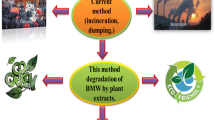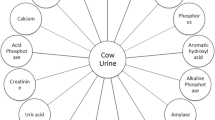Abstract
Management of organic biomedical waste is a global quandary, and it is becoming difficult to confront day by day. Conversion of organic biomedical waste into fertilizer is of great concern. In the present research, organic biomedical waste samples (blood swabs, dressing swabs, and used cotton) were collected then after cow dung was collected in sterile container and immediately transported to the laboratory and screened for any gastrointestinal infection by using routine microscopy for intestinal parasitic infection, routine bacterial culture, and fecal occult blood for any intestinal bleeding. Then after, the pure culture of organisms and fungus were prepared, and further samples were subjected to degradation for 288 h by using various organisms and fungus. Then after, the specific quantity of biomedical waste was subjected for incineration. The physicochemical parameters of biomedical waste samples were analyzed. Then treated samples were mixed with soil to confirm a role as potential fertilizer. Then after, tomato plantation was done and phytochemical parameters of tomato plant were analyzed. This study states that organic biomedical waste produces a sanitary and stable fertilizer.





Similar content being viewed by others
References
Ali SM, Yasmin A (2014) Open dumping of municipal solid waste and its hazardous impacts on soil and vegetation diversity at waste dumping sites of Islamabad city. J King Saud Univ Sci 26:59–65
Anitha J, Jayaaj I (2012) Isolation and identification of bacteria from biomedical waste. Int J Pharm Pharm Sci 4:10–12
Ashley MK, Grant M, Grabov A (2006) Plant responses to potassium deficiencies: a role for potassium transport proteins. J Exp Bot 57:425–436
Atekwana EA, Rowe RS, Werkema DD, Legall FD (2004) The relationship of total dissolved solids measurements to bulk electrical conductivity in an aquifer contaminated with hydrocarbon. EPA. 56:281–294
Baglieria A, Cadilia V, Monterumicib C, Gennaria M, Tabassoc S, Montonerid E, Nardie S, Negreb S (2014) Fertilization of bean plants with tomato plants hydrolysates. Effect on biomass production, chlorophyll content and N assimilation. Sci Hortic 176:194–199
Bansal SK, Singhal Y, Singh R (2012) Biohydrogen production with different ratios of kitchen waste and inoculum in lab scale batch reactor at moderate temperatures. Chem Phytopotentials Health Energy Environ Perspect:213–216
Bennett EM, Carpenter SR, Caraco NF (2001) Human impact on erodable phosphorus and eutrophication: a global perspective. 51:227–234
Bodelier PLE, Laanbroek HJ (2004) Nitrogen as a regulatory factor of methane oxidation in soils and sediments. FEMS Microbiol Ecol 47:265–277
Campion N, Thiel CL, Woods NC, Swanzy L, Landis AE, Bilec MM (2015) Sustainable healthcare and environmental life-cycle impacts of disposable supplies: a focus on disposable custom packs. J Clean Prod 94:46–55
Capoor MR, Bhowmik KT (2017) Current perspectives on biomedical waste management: rules, conventions and treatment technologies. Indian J Med Microbiol 35:157–164
Chakraborty S, Veeregowda S, Gowda L, Sannegowda SN, Tiwari R, Dhama K, Singh SV (2013) Biomedical waste management. Adv Anim Vet Sci (2):67–72
Corwin DL, Lesch SM (2005) Apparent soil electrical conductivity measurements in agriculture. Comput Electron Agric 46:11–43
Das DC, Joseph M, Varghese D (2015) Integrated microbial-vermifiltration technique for ayurvedic industrial effluents. IJERGS 3:338–346
Deb A, Gajbhiye S, Raut S (2017) Awareness about biomedical waste management amongst medical interns- an interventional study from Central India. J Evol Med Dent Sci 6:1256–1259
Dinamarca S, Aroca G, Chamy R, Guerrero L (2018) The influence of pH in the hydrolytic stage of anaerobic digestion of the organic fraction of urban solid waste. Water Sci Technol 48:249–254
Geetha M, Fulekar MH (2008) Bioremediation of pesticides in surface soil treatment unit using microbial consortia. Afr J Environ Sci Technol 2:36–45
Gupta KK, Rana R (2016) Isolation and evaluation of cow dung bacteria for their antimicrobial potential. Biotechnol Int 9(2): 47–54
Gupta KK, Aneja KR, Rana D (2016) Current status of cow dung as a bioresource for sustainable development. Bioresour Bioprocess 3:28
Karhu K, Mattila T, Bergström I, Regina K (2011) Agriculture, ecosystems and environment biochar addition to agricultural soil increased CH 4 uptake and water holding capacity – results from a short-term pilot field study. Agric Ecosyst Environ 140:309–313
Kaur K, Mor S, Ravindra K (2016) Removal of chemical oxygen demand from landfill leachate using cow-dung ash as a low-cost adsorbent. J Colloid Interface Sci 469:338–343
Kiyasudeen K (2016) Composting: a traditional practice. AESE. 45–68
Lakshmi C, Ranjitha J, Vijayalakshmi S (2014) Wastewater treatment using vermifilteration technique at institutional level. J Archaeol Sci 1:581–590
Li J, Jha AK, He J, Ban Q, Chang S (2011) Assessment of the effects of dry anaerobic co-digestion of cow dung with wastewater sludge on biogas yield and biodegradability. Int J Phys Sci 6:3723–3732
Olga MM, Ewa K, Dorota W, Tadeusz A (2015) Biodegradation of diesel oil hydrocarbons enhanced with Mucor circinelloides enzyme preparation. Int Biodeterior Biodegradation 104:142–148
Pandey A, Afsheen, Ara F, Tiwari SK (2011) Isolation and characterization of multidrug resistance cultures from wastewater. JPBMS. 13:1–7
Patil VS, Deshmukh HV (2016) Studies on molds from vegetable waste, cattle dung slurry and biogas digester effluent. Int J Curr Microbiol App Sci 5:182–118
Patil PM, Mahamuni PP, Shadija PG, Bohara A (2019) Conversion of organic biomedical waste into value-added product using green approach. ESPR. 26:6696–6705
Rajakannan C, Govindaradjane S, Sundararajan T (2013) Bio-medical waste management in pondicherry region: a case study. IJEAT 2:75–79
Ramesh Babu B, Parande AK, Rajalakshmi R, Suriyakala P, Volga M (2009) Management of biomedical waste in India and other countries: a review. J Int Environ Appl Sci 4:65–78
Randhawa GK, Kullar JS (2011) Bioremediation of pharmaceuticals, pesticides, and petrochemicals with gomeya/cow dung. ISRN Pharmacol 2011:1–7
Rudraswamy S, Sampath N, Doggalli N (2012) Staff′s attitude regarding hospital waste management in the dental college hospitals of Bangalore city, India. Indian J Occup Environ Med 16:75–78
Sharma P, Kumar M, Mathur N, Singh A, Bhatnagar P, Sogani M (2013) Health care industries: Potential generators of genotoxic waste. Environ Sci Pollut Res 20:5160–5167
Singh SN, Srivastav G, Bhatt A (2012) Physicochemical determination of pollutants in wastewater in Dehradun. Curr World Environ 7:133–138
Thakur V, Ramesh A (2015) Healthcare waste management research: a structured analysis and review (2005–2014). Waste Manag Res 33:855–870
Van Raij B, Quaggio JA, Silva NM (2008) Extraction of phosphorus, potassium, calcium, and magnesium from soils by an ion exchange resin procedure. Commun Soil Sci Plan 17:547–566
Vasistha P, Ganguly R, Gupta AK (2018) biomedical waste generation and management in public sector hospital in Shimla City. Environmental Pollution, Water Science and Technology Library:77
Wang Q, Awasthi MK, Ren XZ, Wang J, Chen M, Zhang H, Zengqiang (2018) Recent advances in composting of organic and hazardous waste: a road map to safer environment. Biosynthetic Technology and Environmental Challenges:307–329
Wuana RA, Okieimen FE (2011) Heavy metals in contaminated soils: a review of sources, chemistry, risks and best available strategies for remediation. ISRN Ecology 20
Xu P, Zhang Y, Kang L, Roossinck MJ, Mysore KS, Division PB, Samuel T, Noble R (2006) Computational estimation and experimental verification of off-target silencing during posttranscriptional gene silencing in plants. Plant Physiol 142:429–440
Funding
The corresponding author (RB) is thankful to D.Y. Patil University for financial support (DYPU/R&D/190). RB is supported through the Irish Research Council under the Government of Ireland Postdoctoral fellowship Grant GOIPD/2017/1283. The funding agencies are gratefully acknowledged.
Author information
Authors and Affiliations
Corresponding author
Ethics declarations
This study was approved by the institutional ethical committee (ICE), D.Y. Patil University, Kolhapur.
Additional information
Responsible editor: Philippe Garrigues
Publisher’s note
Springer Nature remains neutral with regard to jurisdictional claims in published maps and institutional affiliations.
Rights and permissions
About this article
Cite this article
Patil, P.M., Mahamuni, P.P., Abdel-Daim, M.M. et al. Conversion of organic biomedical waste into potential fertilizer using isolated organisms from cow dung for a cleaner environment. Environ Sci Pollut Res 26, 27897–27904 (2019). https://doi.org/10.1007/s11356-019-05795-7
Received:
Accepted:
Published:
Issue Date:
DOI: https://doi.org/10.1007/s11356-019-05795-7




